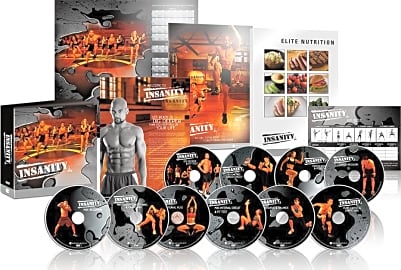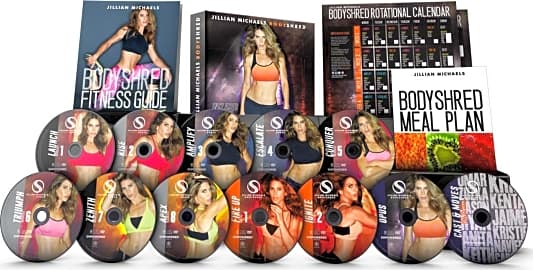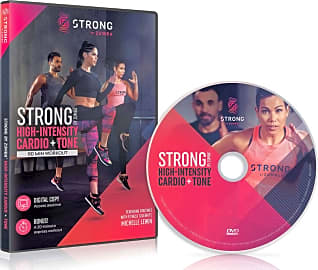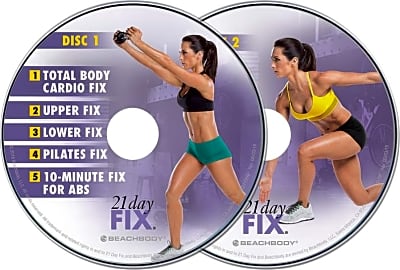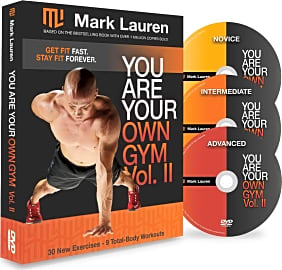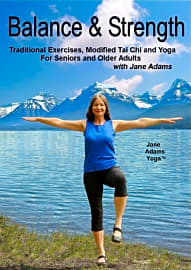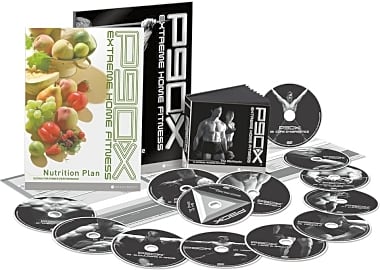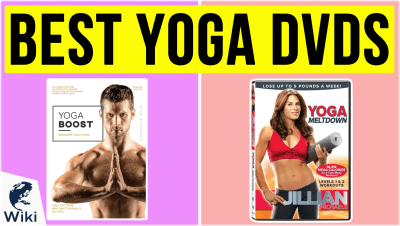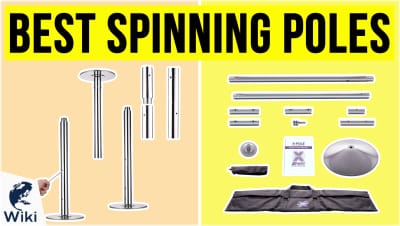The 10 Best Workout DVDs

This wiki has been updated 39 times since it was first published in June of 2015. If you're looking to get in great shape without putting up with crowded gyms, expensive memberships, or lying in pools of other people's sweat, then these exercise DVDs will take your fitness game to the next level. These workouts can be done in the comfort of your own home and, when you see that six-pack staring back at you in the mirror, you'll know they're worth the effort. When users buy our independently chosen editorial choices, we may earn commissions to help fund the Wiki.
Editor's Notes
October 27, 2020:
DVDs are not a new technology by any stretch, so those looking for an exercise program on DVD should expect to get some bang for their buck. That's why the top choices on this list all deliver multiple workouts, providing variety and a total body experience. Choices like Jump Rope Mastery have been removed due to being more niche options, while Insanity MAX:30 has stolen the top spot because it offers many workouts, those workouts are easy to fit into your schedule, and they don't require additional equipment to get results.
A huge part of this category is personality. Shaun T's Insanity is popular because its host is likeable. Same goes for Jackie Warner of Power Circuit Training and Jillian Michaels of Jillian Michaels BodyShred. If you don't like listening to the instructor, you won't stick with the program. It comes down to taste - some people swear by Tony Horton's P90X Base Kit, but some find him far too peppy. He belongs on the list, but it should be noted that he's not for everyone.
Another big reason why a person might seek out a DVD for exercise is that standard workout videos aren't enough to motivate them. For those users, we've added 567 BROADWAY! and have kept Strong by Zumba High Intensity because they're fun and offer something a little different. Balance & Strength has also been added for older users who might be more inclined to stick with a DVD because it doesn't require them to track down a website every time they want to exercise.
November 08, 2019:
In an age of Youtube streaming and fitness apps, people are quick to discount DVD's, but they remain a convenient method for getting a workout in the convenience of your home (assuming you have a DVD player, of course). We wanted options that tackled all sorts of exercise styles, whether you're interested in mixed martial arts, intense cardio, regimented programs that span a finite amount of time, and more.
If you want to harness the strength and power that comes with MMA training, then Tapout XT and Rushfit Ultimate are ideal, but realize that they are tough and might present a substantial challenge for beginners.
For something uncomplicated, yet highly effective, look to Jump Rope Mastery. It takes you through novice, intermediate, and advanced techniques, and includes short how-to videos to ensure you understand what to do. Some of the workouts can be done with a ropeless jump rope, but the more complicated moves require crossover, so bear in mind that you'll need a cabled rope eventually to complete the entire program.
We let go of Focus T25 and Rip:60 Home Gym due to availability concerns. We decided to fill the vacancies with Strong by Zumba High Intensity, a great, budget-friendly selection that's ideal for supplementing yoga, trips to the gym, or for injecting an extra dose of cardio into your week. You'll also notice Power Circuit Training by Jackie Warner joined the ranks as well. These videos are no-nonsense and challenging, and instructor Jackie is knowledgeable and excellent at explaining what you're doing without being incessantly chatty.
Special Honors
Fitness Blender At a certain point, you're going to need to accept that DVDs are not the way of the future. If you're tired of doing the same exercises over and over, Fitness Blender has you covered, offering hundreds of video workouts, many of which are free, covering everything from cardio to kickboxing to kettlebells. fitnessblender.com
Understanding Basic Exercise Types
Examples of aerobic exercise include activities such as hiking, biking, jogging, swimming, or playing basketball.
Before buying a workout DVD, take some time to learn about different types of exercise and how they affect the body. By learning about exercise types, you will be able to tailor your body's needs to exercises that work for you and that can help you achieve your fitness goals. There are three broad categories of exercise: aerobic exercise, anaerobic exercise, and flexibility exercise.
The first, aerobic exercise, also known as cardiovascular exercise or cardio for short, describes activities that aim to increase cardiovascular endurance by stimulating the cardiovascular system for an extended period of time. Examples of aerobic exercise include activities such as hiking, biking, jogging, swimming, or playing basketball.
Anaerobic exercise focuses on building up muscle mass through high intensity, short exertion activities. Examples of anaerobic exercise include jumping, sprinting, weight lighting, interval training, and hill climbing.
Lastly, flexibility exercise aims to improve muscle mobility and range of motion, and typically describes the activities that we associate with stretching.
As mentioned earlier, aerobic exercise is primarily characterized by activities that cause the heart to pump at an accelerated pace for an extended period of time. In addition to referring to activities that engages the heart, aerobic exercise refers to physical exercise that either improves or involves the body's oxygen consumption. When cardio exercise is used alongside a healthy diet and anaerobic exercise, it can contribute to a healthy life. Cardio is a particularly good category of exercise to perform in order to shed pounds, as cardio exercise burns fat as a fuel source. Fats, along with oxygen and carbohydrates, together form the fuel source used by all cells: adenosine triphosphate (ATP). For some aerobic exercise routines to get you started, check out this great list and this informative page.
Anaerobic exercise differs from aerobic exercise in that it is comprised by short bursts of a high-intensity activity such as that repeated during strength training. While aerobic exercise uses oxygen for fuel (an early definition of aerobic is, after all, "living only in the presence of oxygen"), anaerobic exercise draws its fuel from carbohydrates. Anaerobic exercise also produces lactic acid, unlike aerobic exercise. To get started with some anaerobic exercises, check out this list of anaerobic exercises you can do anywhere. While anaerobic exercise does not burn as many calories as aerobic exercise burns, it will still help to improve respiratory and cardiovascular fitness. Additionally, because anaerobic exercise depletes energy more quickly than the blood can replenish the muscles' oxygen, the body's anaerobic metabolism kicks in, burning glucose as fuel. Even after the anaerobic activity has stopped, the metabolism remains increased for up to several hours. If anaerobic exercise is repeated often, it will even have an effect on your resting metabolic rate. This will cause your body to burn more calories in general—even when you're sleeping.
Flexibility exercise, or stretching, is a vital component of any exercise regimen. The primary purpose of flexibility training is to increase your range of motion, especially when it comes to muscles and joints. Although flexibility exercise will not improve your endurance or strength as cardio or anaerobic exercise would, flexibility training helps your body maintain its natural alignment. By doing so, flexibility exercise makes your body significantly less prone to injury during cardio or anaerobic exercise. Additionally, practicing flexibility training will increase your freedom of movement in a way that makes everyday activities easier. Tasks such as reaching up for an object on a shelf, getting up from a chair, or even sitting in confined spaces for long periods of time will greatly benefit from flexibility training.
Ideally, a workout regimen will involve all three of these exercise types, as they each offer different benefits to the body. Focusing on a single exercise type may leave a lot to be desired in other areas that do not benefit from that singular exercise. Take, for example, stretching after a cardiovascular workout session versus stretching completely separately from a cardiovascular workout section. In the former example, stretching offers the maximum benefit to the body's joints and muscles because they have already been warmed up by the cardiovascular exercise, and will stretch further than they otherwise would. In the latter example, the joints and muscles being stretched will not reach their maximum flexibility potential. As such, by using these exercise types together, one can ensure that they are approaching physical fitness from a holistic and balanced perspective.
How to Supplement Your Home Workout DVD
If you really want to get in shape, why not turn some everyday tasks into exercise opportunities Between your DVD-guided workout sessions, finding ways to incorporate exercise into daily tasks may help to make exercise seem like less of an intimidating, dark, scary monster that looms ahead. Finding room for exercise in your daily life could even make exercise—dare I say it—fun.
To help you get started, we made you a list of some alternative, fun exercise opportunities to help you stay fit even while you're doing chores.
- Start dancing. The next time you are about to clean your home, first throw on your favorite dance music and pick up the pace. Try dancing while you clean, and make it a goal to keep moving without taking a break for as long as possible. Really throw your muscles into each activity, and before you know it, you'll be sweatin'.
- When shopping, take some extra laps around the store. Instead of making your shopping trip efficient, take your time and stroll around the store a couple times. If that feels too aimless, add an objective of memorizing the store's layout. Or, when grocery shopping, don't group items on your list by type. Instead, randomize the order so that you get one thing from the produce section and then get something from a different section before getting your next produce item.
- Wash your car. Instead of taking your car to the automatic car wash, wash your car at home. This is a good calorie-burning activity on its own, but you'll burn even more calories if you do some calf raises to reach the top of the car, and some squats while cleaning the lower portions of the car.
- Make bread. Making bread is not only an impressive skill, but also a good workout. Kneading dough works out the upper body, building strength and improving flexibility in the shoulders, arms, chest, and abdomen. Not to mention that you'll be able to enjoy a fun homemade treat when you finish!
- Clean your windows or scrub your shower. While engaging in either of these activities, make large circular motions to improve flexibility and tone your arms. Remember to try and use both arms equally, instead of just using your dominant arm.
- Do you even lift, bro? While putting away groceries, do bicep curls with cans, bottles, or other objects. You can also try holding these objects above your head for ten seconds before putting them away. Alternately, when grocery shopping, opt for a basket instead of a cart when you can. You'll be working out your upper body without even thinking about it.
- How many jumping jacks can you do before the microwave beeps? When using the microwave, see how many jumping jacks you can do before it beeps. To make a game out of it, estimate how many jumping jacks you think you can accomplish before you press start, and find out how close your estimation is.
- Rake those leaves. Raking is already an excellent calorie-burning activity, so do it! Raking is not only great for your yard and lawn, but also for your body. Because your core (your back and abdomen) has to work to stabilize your body while your arms are maneuvering the rake, raking is good exercise for both your arms and core. Weirdly, there's a page all about raking as a workout, which you can read here.
- Park further away. I know a lot of us have developed the (bad) habit of trying to get the parking spot absolutely closest to our destination—I know this because I have both cut-off and been cut-off by some aggressive drivers who really wanted to park 50 feet closer—but this is dumb. Spare yourself the road rage and do your body a favor by parking further away and getting in some extra walking.
- Hop off a stop early. In the same vein as the above tip, if you use public transportation, get off one or two stops early. You'll not only see some new sights, but will also accomplish some extra walking.
- Squat between putting away dishes. During repetitive physical activities such as putting away dishes or loading the dishwasher, throw in a squat, lunge, or other repetitive exercise between each repetition.
- Rearrange a room. For a 150 pound person, moving furniture or boxes can burn around 400 calories an hour! So give a room a new look, get into feng shui, and move your furniture around this weekend.
- Use your toilet time wisely. Take advantage of that toilet time by doing some kegels. Kegels are the muscles used to stop the flow of urination, so practice clenching those muscles the next time you're doing your business. Both men and women can do kegels, which will not only help guard against incontinence, but may also improve bedroom endurance, if you catch my drift.
- Take the stairs. You know, some people pay to use stairs (read: they buy a stair stepper machine), so if you work or live above the first floor, consider using your stairs as a privilege. Using the stairs is great cardiovascular exercise, and also tones your calves, hamstrings, glutes, quadriceps, and abs. Next time you're about to take the elevator or escalator, take the stairs instead. If you have some time to spare, take an extra trip up and down. Or, try a stair-based workout like this one.
- Mix the old-fashioned way. Before electric mixers people mixed things by hand. Next time you're baking and go to use your electric mixer, stop yourself, and instead try mixing by hand. Sure, It takes a little longer and definitely takes more effort, but that's the point.
- Scrub your floors. If you're like most people, you probably can't remember the last time you got down on your hands and knees and gave your floor a good scrub. Scrubbing floors is a great workout for your arms and upper body, so try getting down and dirty with it.
- Wall sit while you brush your teeth. You should be brushing your teeth for two minutes at least twice a day, so take advantage of that precious time by doing some wall sits. At first, you'll probably only last for around 20 seconds, but make it a goal to work up to wall sitting for the whole two minutes that you're brushing your teeth. You might surprise yourself!
- Before using your sink, do some counter pushups. Counter pushups are great for beginners and strengthen your upper body, so make a habit of doing them against the counter before using the sink.
Tracing a Media History of Home Workouts
I must confess: the title of this section is misleading, because while most of us associate the first home workouts with fitness icons Jane Fonda and Richard Simmons, they were not the first ones to bring workouts inside our homes. In fact, before there were VHS tapes, before there were even televised workouts, there were the audio-only vinyl record workouts, nicknamed vinylcise.
Vinylcise has been historically neglected, and probably for good reason: it's terrible, and not very effective—at least not since we've had visual media alternatives. Can you imagine trying to follow along to an audio-only workout? At any rate, these workout records first appeared in the early 1920s, and were usually accompanied by a paper foldout with exercise diagrams. The earliest of these records appear to be the set of five Wallace Reducing Records released in 1920-1922 by the Wallace Institute of Chicago and pressed by Columbia Records. These records were marketed towards women, aiming to help them "get thin to music." Other exercise records of the 1920s included Victor Records for Health Exercises, released in 1922, the Battle Creek Sanitarium Health Ladder, directed by John Harvey Kellogg and released by Columbia Records in 1923, and Walter Camp's Daily Dozen, released in 1924.
Apparently, this trend of guided workout records continued into the 1980s, as evidenced by Jive Time Records' blog Vinylcise. The blog features an archived collection of covers to vinyl exercise records. Some of them are pretty wild, so it's definitely worth checking them out.
Anyhow, this film is significant in that its primary purpose is to display and broadcast forms of exercise to an audience, and it seems to be the first to have done so.
It's hard to pinpoint the first time exercise appeared visually on-screen—meaning on film or video, something that you could see, as opposed to hear—but one of the earliest is the 1928 film Exercise: A Film Lesson in Health and Hygiene. It isn't exactly instructional, but features a bunch of boy scouts showing off some rather bizarre group exercise routines. Check out the bit that starts around 1:22, where they ride each other like human chariots. Anyhow, this film is significant in that its primary purpose is to display and broadcast forms of exercise to an audience, and it seems to be the first to have done so.
In the 1950s postwar period, American capitalism prospered and families began moving to the suburbs. This led to an increase in automobile sales, as driving became a more viable transportation option than walking or taking public transportation, which took a small toll on public health. At the same time, families increasingly owned televisions and stay-at-home mothers spent much of their time at home during the day. As such, stay-at-home mothers became television's primary audience during the day, and created a market for televised workouts.
These factors led to the success of Jack LaLanne's television program, The Jack LaLanne Show. His show popularized guided workouts on TV that were aimed towards women and ran from 1953 until 1985. Many of LaLanne's workouts encouraged viewers to use items that could be found in their own homes, like chairs, as exercise props. In the show's first episode, LaLanne spelled out the program's purpose: "“I’m here for one reason and one reason only: to show you how to feel better and look better so you can live longer."
In 1982, home workouts came to VHS tape when Jane Fonda released her first exercise video, Jane Fonda's Workout. The video had been inspired by the workout book Fonda had released the previous year, Jane Fonda's Workout Book. After its release, Jane Fonda's Workout gradually became a best-seller after more than 200,000 tapes were sold in one year. The tape was the first of its kind, and is sometimes credited with launching the tape industry. Few people owned VCR players when Fonda released her first tape, but as her exercise tape became increasingly popular among Americans and needed to be watched repeatedly in order to be effective, families were encouraged to buy the necessary hardware to play the tape.
The exercise videos became a series, and Fonda eventually released 23 workout videos. Fonda's exercise videos were such a success because they were the first media of their time to send the message that it was socially acceptable for women to participate in exercise culture and become muscular. Fonda's videos also helped to spark the aerobic exercise trend of the 1980s, not to mention the period's iconic fashion trend: a neon exercise outfit with a leotard and leg warmers. The aerobic exercise craze became so widespread that a Muppets parody tape titled Miss Piggy's Aerobique Exercise Workout Album was released in 1982. The album cover featured Miss Piggy in a Fonda-esque exercise outfit, complete with leg warmers and a leotard, in a pose imitating that which was famously modeled by Jane Fonda on the cover of her first tape.
In 1988, Richard Simmons released his popular exercise video, Sweatin' to the Oldies, consisting of energy-packed workouts set to music by a live band. In his workouts, Simmons is so lively and enthusiastic that the workout seems less about grueling exercise and more about jovial fun. This is still the case for Simmons—as he said in a 2012 interview with the Chicago Tribune, " I try to be the clown and court jester and make people laugh. At the same time, you have people in the hospital who have had gastric bypass or lap-band surgery and they still have to work out." While Simmons's workouts have been successful, he takes a different approach than that of Fonda by not grouping any given set of his exercises with any one muscle group. You may not know what specific part of your body you're working out, but boy, you still feel it.
The 1980s also brought the grueling workouts from Buns of Steel with Greg Smithey. In Buns of Steel, Smithey guided viewers in a series of rigorous exercises aimed to tone their rears and thighs. Despite the rigor and intensity of the workout, or perhaps because of it, over one million copies of the VHS tape were sold. That said, I can't help but wonder how much of Smithey's—also called the Bunmaster— success is due to his uncomfortably vivid and surreal line: "Don't forget to squeeze those cheeseburgers out of those thighs!" Wait, what? Smithey comes off as pretty sleazy throughout his tapes, but don't let that stop you. The workout is, after all, titled Buns of Steel.
Since then, there have been a huge variety of celebrity workout shows and videos, and with workout DVDs constituting a common category of media even today. You can even find Kim Kardashian on the workout program, Fit In Your Jeans by Friday.
Impress your friends with your now-extensive knowledge of the most obscure, niche media history ever.



